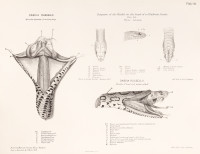Head of a Russell's viper
Date
1872
Creator
Hurrish Chunder Khan (Indian) , Artist
Object type
Archive reference number
Material
Dimensions
height (drawing): 275mm
width (drawing): 415mm
width (drawing): 415mm
Subject
Content object
Description
Anatomical study of the head of a Russell’s viper in right profile, Daboia Russellii, dissected, with pins holding flesh back to reveal the poison duct and gland.
Inscribed in ink: ‘DABOIA RUSSELLII./ Muscles of head and poison gland/ AA. Fascia covering temporal muscles anterior an dposterior./ B. Small gland./ C. Tendinous insertion of fascia./ D. Poison duct./ E. Fang./ F. Reserve fangs./ G. Mandible./ H. Ectopterygoid muscle and a portion of its fascia./ J. Poison gland covered by fascia and masseter muscle./ K. Masseter inserted into mandible./ L. Temporal insertion./ M. Digastric./ Govt: School of Art, Calcutta. Drawn by Hurrish Chunder Khan Student. From a dissection by J. Fayrer M. D.’ With further pencil annotation ‘8’. Pencil annotations believed to be in Joseph Fayrer’s hand.
From MS/628, a set of paintings and drawings executed by students of the Government School of Art, Kolkata, for Joseph Fayrer’s The Thanatophidia of India. Later published as part of plate 30 of this text.
Hurrish Chunder Khan, student at the Government School of Art, Kolkata.
Sir Joseph Fayrer, first baronet, (1824-1907), surgeon and author, was elected a Fellow of the Royal Society in 1877. Fayrer worked in India between 1850 and 1872 and is best known for The Thanatophidia of India, a study of venomous snakes, illustrated by members of the Kolkata School of Art and published by the colonial government.
Inscribed in ink: ‘DABOIA RUSSELLII./ Muscles of head and poison gland/ AA. Fascia covering temporal muscles anterior an dposterior./ B. Small gland./ C. Tendinous insertion of fascia./ D. Poison duct./ E. Fang./ F. Reserve fangs./ G. Mandible./ H. Ectopterygoid muscle and a portion of its fascia./ J. Poison gland covered by fascia and masseter muscle./ K. Masseter inserted into mandible./ L. Temporal insertion./ M. Digastric./ Govt: School of Art, Calcutta. Drawn by Hurrish Chunder Khan Student. From a dissection by J. Fayrer M. D.’ With further pencil annotation ‘8’. Pencil annotations believed to be in Joseph Fayrer’s hand.
From MS/628, a set of paintings and drawings executed by students of the Government School of Art, Kolkata, for Joseph Fayrer’s The Thanatophidia of India. Later published as part of plate 30 of this text.
Hurrish Chunder Khan, student at the Government School of Art, Kolkata.
Sir Joseph Fayrer, first baronet, (1824-1907), surgeon and author, was elected a Fellow of the Royal Society in 1877. Fayrer worked in India between 1850 and 1872 and is best known for The Thanatophidia of India, a study of venomous snakes, illustrated by members of the Kolkata School of Art and published by the colonial government.
Object history
These artworks were presented to the Royal Society on 8 January 1874 by Joseph Fayrer and acknowledged shortly after at a meeting of Council: ‘Read a letter from Dr. Fayrer, offering his collection of original drawings of the Poisonous Snakes of India to the Royal Society. Resolved - That Dr. Fayrer’s offer be accepted, and that the best thanks of the President and Council be returned to him for his gift.’ [Royal Society Minutes of Council, Printed, vol. 4, 1870-1877, p.204, 15 January 1874.]
Related fellows
Joseph Fayrer (1824 - 1907, British) , Surgeon
Associated place
